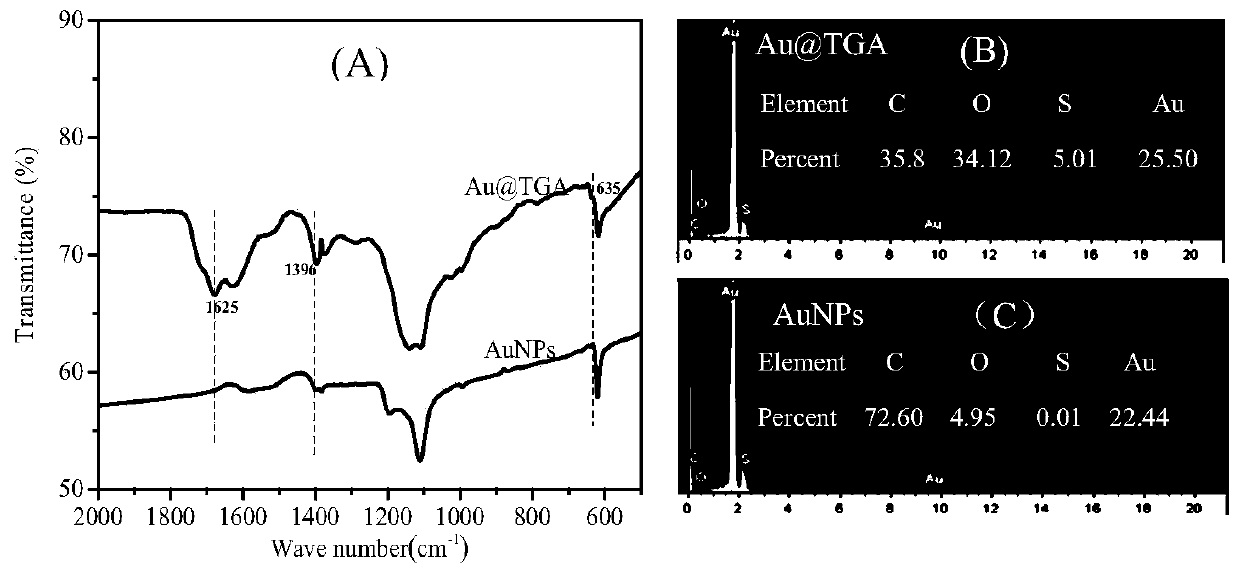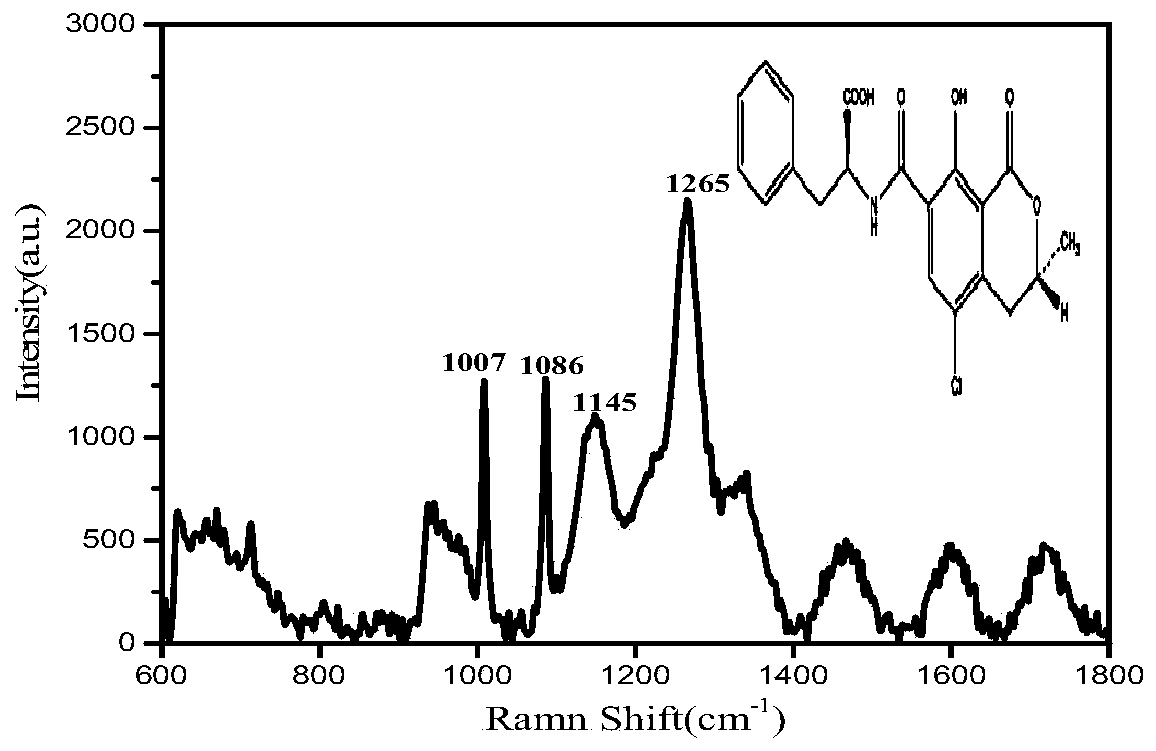SERS detection method for ochratoxin A
A technology of ochratoxin and detection method, which is applied in the field of detection of mycotoxins, and can solve problems such as time-consuming, inability to meet the needs of food quality and safety control, and inability to meet quick inspections
- Summary
- Abstract
- Description
- Claims
- Application Information
AI Technical Summary
Problems solved by technology
Method used
Image
Examples
Embodiment 1
[0028] 1) Synthesis of Au nanoparticles:
[0029] Au nanoparticles (AuNPs) solutions were prepared by reducing chloroauric acid with sodium citrate. Under boiling conditions, quickly add 1.4mL 1% trisodium citrate solution to 200mL chloroauric acid solution with a mass concentration of 0.01%. After the solution turns wine red, continue the reaction for 30min, and cool naturally to room temperature to prepare Au nanoparticle solution with a particle size of approximately 55 nm.
[0030] 2) Preparation and characterization of TGA modified gold nanoparticles:
[0031] Take 40 mL of the above-mentioned gold nano-sol in a clean round bottom flask, add the TGA solution dropwise under 1000r / min magnetic stirring, and continue the reaction for 20 minutes to obtain TGA-modified gold nanoparticles. The synthesized TGA-modified gold nanoparticles were Infrared spectrum, EDS, SEM characterization.
[0032] Take the TGA-modified gold nanoparticles in step 2), concentrate and put them to...
Embodiment 2
[0037] 1) Synthesis of Au nanoparticles:
[0038] Au nanoparticles (AuNPs) were prepared by reducing chloroauric acid with sodium citrate. Under boiling conditions, quickly add 1.4mL 1% trisodium citrate solution to 200mL chloroauric acid solution with a mass concentration of 0.01%. After the solution turns wine red, continue the reaction for 30min, and cool naturally to room temperature to prepare Au nanoparticle solution with a particle size of approximately 55 nm.
[0039] 2) Synthesis of TGA-modified gold nanoparticles and preparation of SERS substrate:
[0040] Take 40 mL of the above-mentioned gold nano solution in a clean round bottom flask, add 200 μL TGA solution dropwise under 1000 r / min magnetic stirring, and continue the reaction for 20 min to obtain a TGA-modified gold nano particle solution. Take 1.0 mL of the synthesized TGA-modified gold nanoparticle solution, centrifuge at 7000 r / min for 5 min, discard the supernatant, add 200 μL ultrapure water to wash once...
Embodiment 3
[0046] 1) Synthesis of Au nanoparticles:
[0047] Au nanoparticles (AuNPs) were prepared by reducing chloroauric acid with sodium citrate. Under boiling conditions, quickly add 1.4mL 1% trisodium citrate solution to 200mL chloroauric acid solution with a mass concentration of 0.01%. After the solution turns wine red, continue the reaction for 30min, and cool naturally to room temperature to prepare Au nanoparticles with a particle size of approximately 55nm.
[0048] 2) Synthesis of TGA-modified gold nanoparticles and preparation of SERS substrate:
[0049] Take 40 mL of the above-mentioned gold nano-sol in a clean round bottom flask, add 200 μL of TGA solution dropwise under 1000 r / min magnetic stirring, and continue the reaction for 20 min to obtain a TGA-modified gold nano-particle solution. Take 1.0 mL of the synthesized TGA-modified gold nanoparticle sol, centrifuge at 7000 r / min for 5 min, discard the supernatant, wash once with 200 μL ultrapure water, and concentrate ...
PUM
 Login to view more
Login to view more Abstract
Description
Claims
Application Information
 Login to view more
Login to view more - R&D Engineer
- R&D Manager
- IP Professional
- Industry Leading Data Capabilities
- Powerful AI technology
- Patent DNA Extraction
Browse by: Latest US Patents, China's latest patents, Technical Efficacy Thesaurus, Application Domain, Technology Topic.
© 2024 PatSnap. All rights reserved.Legal|Privacy policy|Modern Slavery Act Transparency Statement|Sitemap



